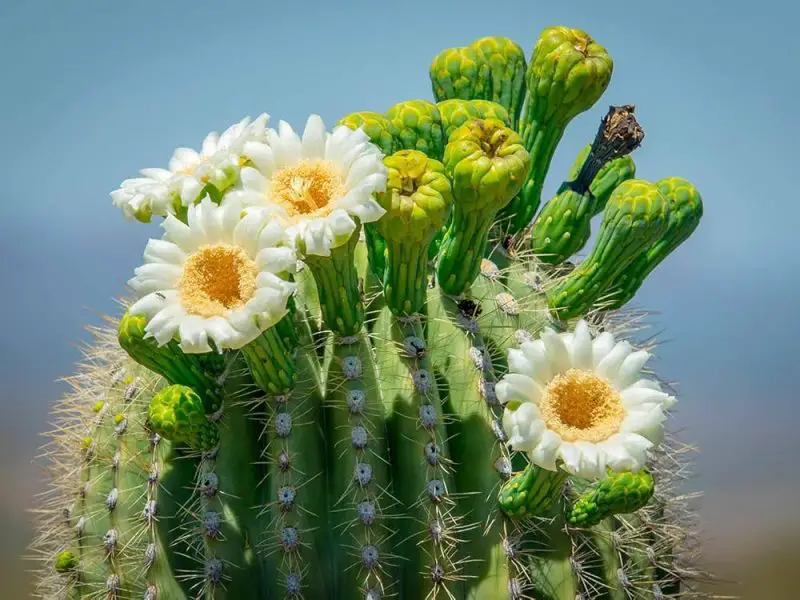The saguaro cactus is one of the most striking symbols of the American Southwest. With towering arms that can reach the sky, it stands as a natural monument of endurance and beauty. Few plants capture the imagination the way saguaros do, inspiring awe in visitors and scientists alike.
Yet many people wonder, where do saguaro cactus grow? The answer is more fascinating than it seems. These giants survive only in very specific desert regions, relying on unique climate patterns and soil conditions. Exploring their range not only reveals where they flourish but also uncovers the secrets behind their survival in some of the harshest environments on earth.
Geographic Range of the Saguaro Cactus

The saguaro cactus has a very limited natural range, making it one of the most region-specific plants in North America. It grows primarily in the Sonoran Desert, which stretches across southern Arizona, southeastern California, and northwestern Mexico. Within this desert, saguaros thrive only in certain areas where elevation, rainfall, and temperature create the right balance for growth. This restricted distribution adds to the cactus’s mystique and highlights its delicate relationship with the environment.
In Arizona, saguaros dominate landscapes around Tucson and Phoenix, where conditions are nearly perfect for them. They also extend into parts of northern Mexico, particularly the state of Sonora, from which the desert takes its name. However, they do not grow across the entire Sonoran Desert. Their range is carefully defined by both natural barriers and subtle environmental changes. Too much frost in higher elevations or extreme drought in harsher desert sections prevents their survival.
Elevation plays a critical role in shaping the saguaro’s habitat. These cacti typically grow between 1,000 and 4,000 feet above sea level. Below this range, conditions may be too hot and dry, while above it, winter freezes can damage their tissues. This narrow range demonstrates the cactus’s dependence on a finely balanced climate. Understanding the geographic limits of the saguaro helps explain why it remains such a rare and treasured plant, confined to one of the world’s most distinctive deserts.
Climate Conditions Required for Saguaro Growth
Temperature Needs
The saguaro cactus depends on extreme heat for its survival. In the Sonoran Desert, daytime temperatures in summer can soar above 100°F, and saguaros are perfectly adapted to withstand these harsh conditions. The thick, pleated stem acts as both a shield and a reservoir, protecting the plant from scorching sun while storing water and nutrients. These high temperatures also promote faster photosynthesis, which allows the cactus to grow taller and develop the iconic arms that define its appearance.
Still, cold is the cactus’s greatest enemy. Saguaros cannot endure prolonged freezing weather, and even short frosts can leave scars or kill young plants. Mature saguaros are more tolerant, but sustained temperatures below 28°F remain dangerous. This explains why they are absent from cooler high deserts or elevated plateaus. The limited tolerance to frost creates a sharp boundary for their distribution, keeping them restricted to warm, low-lying deserts where winter remains mild and survivable.
Rainfall and Water Availability
The Sonoran Desert is unique because it receives two main rainy seasons: summer monsoons and winter showers. This pattern provides saguaros with the water they need at critical times of the year. Their root system is shallow but spreads out widely to capture sudden bursts of rainfall. Within hours, the cactus can swell noticeably as it absorbs water, storing it within its ribbed stem for future use. This adaptation ensures survival through months of scorching drought when no new rain falls.
However, the balance must be precise. Too much rainfall creates conditions that saguaros cannot tolerate, such as flooding and fungal growth. On the other hand, prolonged drought prevents germination of new seedlings, threatening population renewal. Ideal conditions combine scarcity with sudden abundance, where heavy rains arrive briefly and then vanish. This rhythm has shaped the cactus’s evolution and explains why saguaros are confined to the Sonoran Desert, where the rainfall pattern fits their survival strategy perfectly.
Soil and Drainage Conditions
Saguaros thrive in soils that provide excellent drainage, such as sandy, gravelly, or rocky ground. These soil types allow water to seep quickly, preventing dangerous pooling around the roots. The cactus has evolved to anchor itself firmly in these substrates while maximizing water intake. On rocky slopes, saguaros find natural drainage channels, while in desert flats, their shallow roots spread wide to capture even light rainfall. This unique adaptation helps them take advantage of water without suffering from oversaturation.
Poorly drained soils, such as heavy clay, pose a serious risk. Excess water lingers in such soils and promotes root rot, a deadly condition for saguaros. Because of this, they cannot survive in wetlands or regions where the soil retains too much moisture. Their dependence on well-drained soil shows just how specialized they are for desert life. The delicate balance between water absorption and root health reflects a survival strategy perfected over centuries in one of the toughest climates on earth.
Adaptations That Help Saguaros Survive
Water Storage and Conservation
The saguaro cactus survives in one of the driest environments by storing water with remarkable efficiency. Its accordion-like ribs expand dramatically after rainfall, sometimes increasing the plant’s weight by thousands of pounds. This reservoir can sustain the cactus for months, even during long droughts. The waxy skin covering its surface adds another layer of protection, sealing in moisture against intense desert heat. Without these features, the saguaro would wither quickly in its harsh surroundings.
In addition, saguaros rely on a unique form of photosynthesis called CAM. Instead of opening their stomata during the hot daytime hours, they open them at night to absorb carbon dioxide. This small but crucial adjustment reduces water loss and helps them maintain hydration. Together, these traits allow saguaros to thrive where other plants fail. Their entire physiology revolves around water management, proving that survival in the desert is a matter of perfect timing and conservation.
Defensive Structures
Survival in the desert also requires effective defenses, and the saguaro’s spines play a central role. These sharp, needle-like structures discourage animals from eating the cactus’s juicy flesh. Beyond deterring predators, the spines provide micro-shade, creating cooler spots along the plant’s surface. This reduces the overall temperature of the stem, preventing overheating and water loss during scorching summer days. Spines are therefore both armor and climate regulators, essential to the cactus’s daily survival.
The ribs of the saguaro add another layer of adaptation. These vertical ridges allow the plant’s body to expand and contract as it absorbs or releases water. During rainy seasons, saguaros swell significantly, while in drought, they shrink without tearing their tough skin. This flexibility prevents physical damage that could invite disease or pests. Together, spines and ribs show how structural adaptations are just as critical as physiological ones, giving the saguaro a unique edge in desert survival.
Longevity and Slow Growth
The saguaro’s growth strategy is as remarkable as its physical form. For the first several years, young saguaros grow only a few centimeters per year, blending into the desert floor and avoiding attention from herbivores. This slow development helps them establish strong root systems and adapt gradually to fluctuating conditions. By the time they stand tall, they are already resilient survivors, equipped to handle drought, heat, and occasional storms.
Their longevity is equally impressive, with some individuals reaching 150 to 200 years of age. Over this vast timespan, they endure cycles of drought and flood, adapting continuously to their environment. Their iconic arms, which often appear only after 50 to 70 years, increase photosynthetic capacity and provide balance for the tall structure. Slow growth and extraordinary lifespan are intertwined, ensuring saguaros not only survive but also dominate desert landscapes for generations. This adaptation secures their place as true giants of the American Southwest.
Ecosystems That Support Saguaro Cactus
Desert Valleys and Flats
Saguaros are often found in broad desert valleys where water drains slowly yet does not pool excessively. These valleys provide a balance between moisture and dryness, creating favorable conditions for germination. The soil in these flats is typically sandy or gravelly, which helps water penetrate quickly while avoiding root rot. As saguaros mature, their towering forms become a defining feature of these wide-open landscapes, symbolizing the resilience of desert ecosystems. These valleys also receive more consistent sunlight than shaded canyons, giving saguaros the warmth they require throughout the year.
In these valleys, saguaros often coexist with other desert plants like creosote bushes and palo verde trees. This plant community forms a natural balance, with each species playing a role in conserving water and stabilizing soil. Saguaros also benefit from the shelter these plants provide during their early years. Young cacti often sprout under “nurse plants” that shield them from harsh sun until they are strong enough to stand on their own. Over time, the valleys become living mosaics where saguaros grow alongside diverse flora and fauna, creating some of the most recognizable desert landscapes in North America.
Rocky Slopes and Foothills
Rocky slopes and foothills provide another ideal habitat for saguaros. The rocks improve drainage and prevent excessive moisture from accumulating near the roots. These elevated areas also expose saguaros to more sunlight, which is essential for their growth and survival. The combination of rocky ground and direct sunlight allows saguaros to thrive in conditions that might seem too harsh for other plants. The rocks themselves also radiate stored heat at night, offering additional warmth during cooler desert evenings and creating a more stable microclimate for the cacti.
In addition, slopes protect saguaros from cold air that settles in low valleys during winter. This natural insulation reduces the risk of frost damage, which can be fatal to young cacti. These rocky foothills are often shared with other desert species, such as mesquite trees and desert shrubs, which contribute to biodiversity and provide shelter for animals. Many of the most iconic desert landscapes, dotted with giant saguaros against a backdrop of rugged hills, highlight how these plants flourish in rocky terrain. Their presence not only stabilizes soil but also sustains wildlife by offering food, nesting sites, and shade in an otherwise harsh environment.
Relationships with Other Plants
The saguaro cactus does not grow in isolation; it forms part of a complex ecosystem with many other desert plants. Trees like palo verde and mesquite often act as nurse plants, providing shade and reducing evaporation for young saguaros. Without this early protection, many seedlings would not survive the scorching desert sun. These nurse plants also enrich the soil by fixing nitrogen, which benefits surrounding vegetation and indirectly supports saguaro growth. As saguaros grow taller, they eventually surpass these trees, but the early relationship is critical for their survival and establishment.
Other plants also contribute indirectly by shaping soil conditions and helping conserve scarce water. Ground cover plants prevent erosion and stabilize the thin desert soil, while shrubs create microhabitats that shield seedlings from wind and temperature extremes. Creosote bushes, for example, help trap organic matter, adding nutrients to the soil that can benefit nearby saguaros. The interdependence among desert plants demonstrates how survival in such a hostile environment requires cooperation. The saguaro may be a giant symbol of the desert, but its success is deeply tied to the presence of its plant neighbors throughout its life cycle.
Relationships with Animals
The saguaro cactus maintains vital relationships with desert animals, many of which depend on it for food and shelter. Its large, white flowers bloom at night and are pollinated by bats, moths, and other nocturnal visitors. During the day, bees and birds also help with pollination, ensuring the survival of the species. Once the flowers give way to bright red fruit, a wide range of animals, including doves, finches, and coyotes, consume the sweet pulp and disperse the seeds across the desert. This cycle highlights the cactus’s central role in sustaining biodiversity within its ecosystem.
Beyond food, saguaros provide critical shelter. Gila woodpeckers and gilded flickers carve nesting cavities in the cactus’s flesh, which later become homes for owls, wrens, and other small birds. Mammals such as bats and pack rats also benefit from the shade and microhabitats saguaros create. Even after death, the woody ribs of a saguaro offer perches and refuge for wildlife. These interactions reveal the cactus’s importance as more than just a plant—it serves as a living hub that supports countless desert creatures, making it essential for ecological balance.
Human Connections and Cultural Importance
The saguaro cactus is not only vital to the desert ecosystem but also deeply significant to human culture. Indigenous peoples of the Sonoran Desert, such as the Tohono O’odham Nation, have long viewed the saguaro as a sacred plant. They traditionally harvest the cactus’s fruit in summer, using it to make syrup, wine, and ceremonial drinks. These harvests are carried out with respect, guided by cultural rituals that honor the cactus as a living relative rather than just a resource. The saguaro is woven into oral traditions, songs, and stories that highlight its role as a symbol of endurance, community, and spiritual connection to the land.
In modern times, the saguaro has become an icon of the American Southwest. Its towering silhouette is widely recognized in art, film, and popular culture, often symbolizing the rugged beauty of desert life. Conservation efforts have also grown around this cultural importance, leading to protections within national parks and reserves. For many, the saguaro represents both natural resilience and cultural continuity, reminding people that human survival in the desert has always been tied to a deep respect for the land and its resources.
Climate and Environmental Adaptations
The saguaro cactus has evolved an extraordinary set of adaptations that allow it to thrive in the Sonoran Desert, where rainfall averages less than 12 inches a year. One of its most remarkable features is the pleated outer skin, which expands and contracts depending on water availability. After even a brief desert rain, saguaros can quickly absorb and store thousands of liters of water, enough to keep them alive during prolonged droughts. The waxy cuticle covering its surface also minimizes evaporation, reducing water loss under relentless sun.
Another critical adaptation is its shallow yet extensive root system. These roots stretch as far as the cactus is tall, allowing it to capture as much rainwater as possible before it evaporates into the dry desert air. Some roots are only a few inches below the surface, giving the cactus the ability to react instantly to rainfall. Beneath this, a deep taproot anchors the plant, providing stability against harsh desert winds. Together, these systems give the saguaro both resilience and efficiency in water management.
Temperature extremes further shape how saguaros endure. The cactus uses a unique process called CAM photosynthesis, opening its pores at night to minimize water loss while still absorbing carbon dioxide for photosynthesis. Its spines not only protect it from animals but also create tiny shadows, reducing surface heat. The ribs along its body act like heat regulators, breaking up direct sunlight and cooling the plant’s surface. With these strategies, the saguaro becomes a model of survival, capable of living for centuries in an environment where other plants wither within days.
Seasonal Rhythms and Flowering Cycles
The saguaro cactus lives in harmony with the desert’s seasonal cycles, adjusting its growth, flowering, and reproduction to the rhythms of temperature and rainfall. Flowering typically begins in late April and extends through June, coinciding with the rise of warm nighttime temperatures. Its blossoms are striking, large, and waxy white, opening at dusk to attract bats and moths and staying open into the morning to draw bees and birds. This timing ensures maximum pollination opportunities, as both nocturnal and daytime pollinators play crucial roles in the cactus’s reproduction.
Once pollination occurs, the flowers develop into vivid red fruits that ripen by midsummer, one of the most extreme periods of heat in the desert. The fruits split open dramatically, exposing a sweet pulp filled with thousands of tiny black seeds. Wildlife such as birds, coyotes, and insects feed on the fruits, while simultaneously dispersing seeds across wide distances. This natural partnership between the saguaro and animals guarantees its regeneration while feeding countless creatures at a time when food is scarce.
The life cycle of the saguaro is also closely tied to the summer monsoon rains. When heavy storms arrive in July and August, the freshly dispersed seeds have a higher chance of germination in moist soil. Many seedlings sprout beneath protective nurse plants, increasing their odds of survival. This seasonal rhythm reflects the cactus’s deep integration into the desert’s ecological calendar, where every bloom and fruit supports not just its survival but also the broader web of life. In this way, the saguaro stands as a keystone species, marking the pulse of the desert’s year.
Longevity and Growth Patterns
The saguaro cactus is one of the longest-living plants in North America, with lifespans often reaching 150 to 200 years. During its early years, growth is extremely slow; in the first decade, a seedling may only grow a few inches tall. This slow start makes the young cactus vulnerable to heat, frost, and grazing animals, which is why nurse plants like mesquite and palo verde are crucial for its survival. These protective plants shield the saguaro from extreme sunlight and create microclimates that foster gradual growth until the cactus is mature enough to withstand harsh desert conditions.
By the time a saguaro reaches 50 to 70 years of age, it begins producing its first arms, a milestone in its development. Each arm increases the plant’s capacity for flowering and fruiting, greatly enhancing reproduction. Mature saguaros can grow over 40 feet tall and weigh several tons when filled with water, making them some of the most imposing figures in the desert landscape. Despite their massive size, they remain slow growers, adding only a few inches in height each year after maturity.
Even after death, saguaros continue to play a role in the desert ecosystem. Their woody ribs provide structure and shelter for birds, small mammals, and insects, while decomposed plant material enriches the soil. The long life cycle and gradual growth patterns of the saguaro symbolize endurance, patience, and resilience in an unforgiving environment. Each stage of its growth tells a story of adaptation and survival, showing how life in the desert requires balance, persistence, and deep interconnection with the surrounding ecosystem.
Threats and Conservation Efforts
Despite their resilience, saguaro cacti face growing threats in the modern era. Climate change is one of the most pressing challenges, as rising temperatures and prolonged droughts stress the plants and reduce their ability to store water. Unseasonal frosts also damage young saguaros, which are particularly vulnerable during their first decades of life. In addition, invasive plant species such as buffelgrass increase the risk of wildfires, which spread rapidly and devastate desert habitats where saguaros have thrived for centuries.
Human activity adds further pressure. Urban expansion, road construction, and recreational damage all contribute to habitat loss and fragmentation. Saguaros grow slowly and take decades to mature, meaning that any destruction of young populations has long-term consequences for the entire ecosystem. Illegal poaching, where saguaros are dug up and sold, has also posed a problem, though stronger enforcement in recent years has helped curb this practice. These threats highlight the fragile balance between natural endurance and external pressures in the Sonoran Desert.
Conservation efforts have become increasingly important in preserving this desert giant. Protected areas such as Saguaro National Park in Arizona safeguard large populations and allow research on long-term survival strategies. Local communities, indigenous groups, and scientists work together to restore habitats and remove invasive grasses to reduce fire risk. Public education campaigns encourage respect for saguaros and emphasize their ecological and cultural value. By combining traditional knowledge with modern conservation science, these efforts ensure that saguaros continue to stand tall, serving as a symbol of both desert resilience and the importance of environmental stewardship.
Role in Desert Ecosystem
The saguaro cactus serves as a keystone species in the Sonoran Desert, meaning its presence is essential for maintaining ecological balance. Its towering body and seasonal fruits provide resources for countless animals. From bees pollinating its blossoms to birds, bats, and coyotes feeding on its fruits, the saguaro sustains life across multiple trophic levels. By producing thousands of seeds each season, it also ensures the continuation of desert biodiversity, even though only a few seedlings survive to maturity.
Beyond food, saguaros offer shelter and protection. Gila woodpeckers and flickers excavate nest holes in the cactus’s flesh, creating homes not only for themselves but also for owls, wrens, and other birds that later reuse the cavities. Mammals and reptiles find shade beneath its broad arms, while insects thrive in the microhabitats it creates. Even fallen saguaros continue to benefit the ecosystem, as their woody ribs decompose and enrich the soil with nutrients, supporting new plant growth.
The influence of the saguaro extends beyond individual interactions. By stabilizing soil, providing shade, and shaping microclimates, saguaros help other plants and animals survive in the harsh desert environment. Their seasonal cycles of flowering and fruiting create predictable rhythms that many species depend on. Without saguaros, the desert would lose not only a striking visual landmark but also the foundation of its ecological web. This vital role demonstrates why conserving saguaros is about more than protecting a single species—it is about preserving the integrity and resilience of the entire Sonoran Desert ecosystem.
Fascinating Facts and Symbolism
The saguaro cactus is full of fascinating traits that make it one of the most iconic plants in the world. Some individuals grow more than 40 feet tall and can weigh up to 4,800 pounds when fully hydrated, making them true giants of the desert. Remarkably, a saguaro can live for over two centuries under the right conditions, with its first arm often appearing only after 50 to 70 years of growth. Each mature cactus can produce tens of thousands of seeds in a single year, though only a handful may ever germinate and survive.
Saguaros also display striking diversity in their forms. While most develop multiple arms, some remain unbranched for their entire lives, resembling towering columns. Rarely, genetic mutations produce a crested or “cristate” saguaro, where the top of the cactus fans out into unusual, wavy shapes. These rare specimens attract scientists, photographers, and tourists alike, symbolizing the wonder of natural variation and resilience in harsh environments.
Culturally, the saguaro has become a symbol of the American Southwest. Its distinctive silhouette appears in films, paintings, and tourism promotions, representing both rugged beauty and survival against the odds. For indigenous peoples, however, the saguaro holds deeper meaning—signifying community, tradition, and spiritual connection with the land. This dual symbolism, blending popular imagery with cultural heritage, reinforces the cactus’s status as more than just a plant. It is a living emblem of endurance, identity, and the timeless spirit of the desert.
FAQ About Where Saguaro Cactus Grow
Where do saguaro cactus naturally grow?
Saguaro cactus naturally grow in the Sonoran Desert, mainly in southern Arizona, parts of southeastern California, and northwestern Mexico. They thrive in desert valleys, rocky slopes, and flatlands where temperatures are high, sunlight is intense, and soil drains well, creating the perfect conditions for their survival.
Can saguaro cactus grow outside the desert?
Saguaro cactus are highly specialized for desert life and rarely survive outside their natural habitat. They struggle in regions with cold winters, high humidity, or poorly draining soil. While they may grow in cultivation under controlled conditions, their towering size and climate needs make them difficult to maintain elsewhere.
How tall can a saguaro cactus grow?
A mature saguaro cactus can reach heights of 40 to 60 feet and weigh several tons when fully hydrated. Their slow growth means it may take decades before they develop their first arms. With ideal conditions, these giants can live up to 150–200 years, becoming iconic desert landmarks.
What animals depend on saguaro cactus?
Many desert animals rely on the saguaro for shelter, food, and water. Birds like the Gila woodpecker and elf owl nest in its cavities, while bats, bees, and doves pollinate its flowers. Its fruit feeds mammals and birds, making the saguaro a keystone species in the Sonoran Desert ecosystem.
Are saguaro cactus protected by law?
Yes, saguaro cactus are protected under Arizona state law. Removing, damaging, or destroying a saguaro from the wild is illegal without proper permits. Their protected status ensures the survival of these ancient plants, which play a vital role in desert biodiversity and cultural heritage for indigenous communities.
Conclusion
The saguaro cactus is more than a desert giant—it is a living symbol of resilience, balance, and survival. From its intricate relationships with animals and plants to its cultural importance for indigenous peoples, the saguaro shapes both ecosystem and identity. Its towering form defines the Sonoran Desert, offering food, shelter, and inspiration across generations. Yet, its survival depends on careful conservation and respect for its fragile environment. By protecting saguaros, we preserve not only a plant but also the story of endurance and harmony that they represent within one of Earth’s most unique landscapes.






